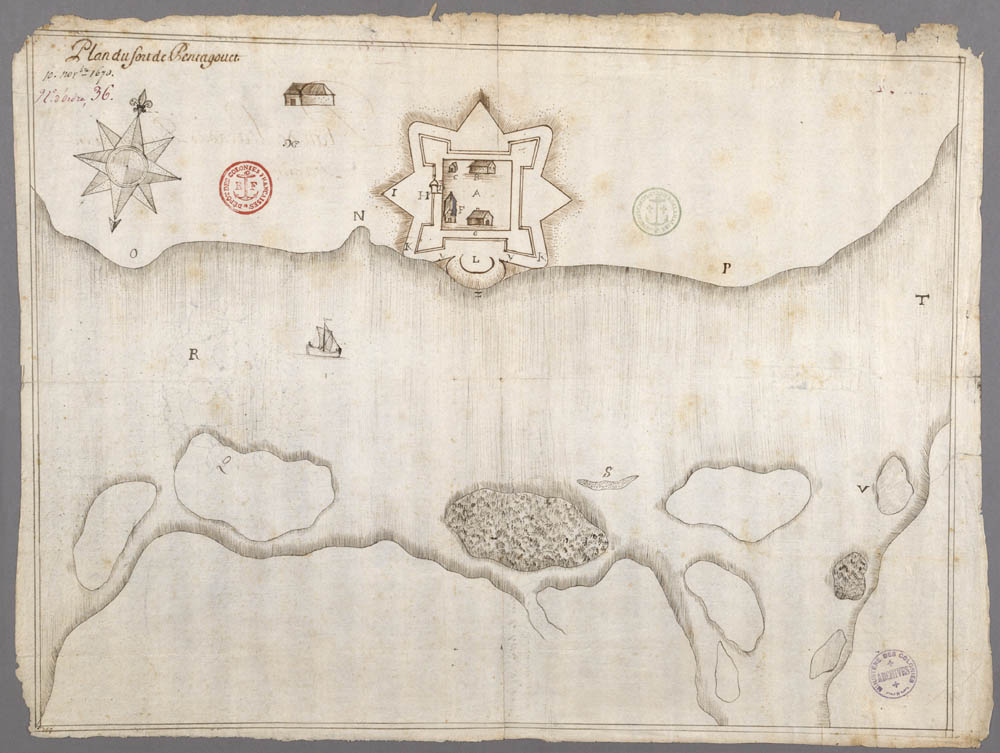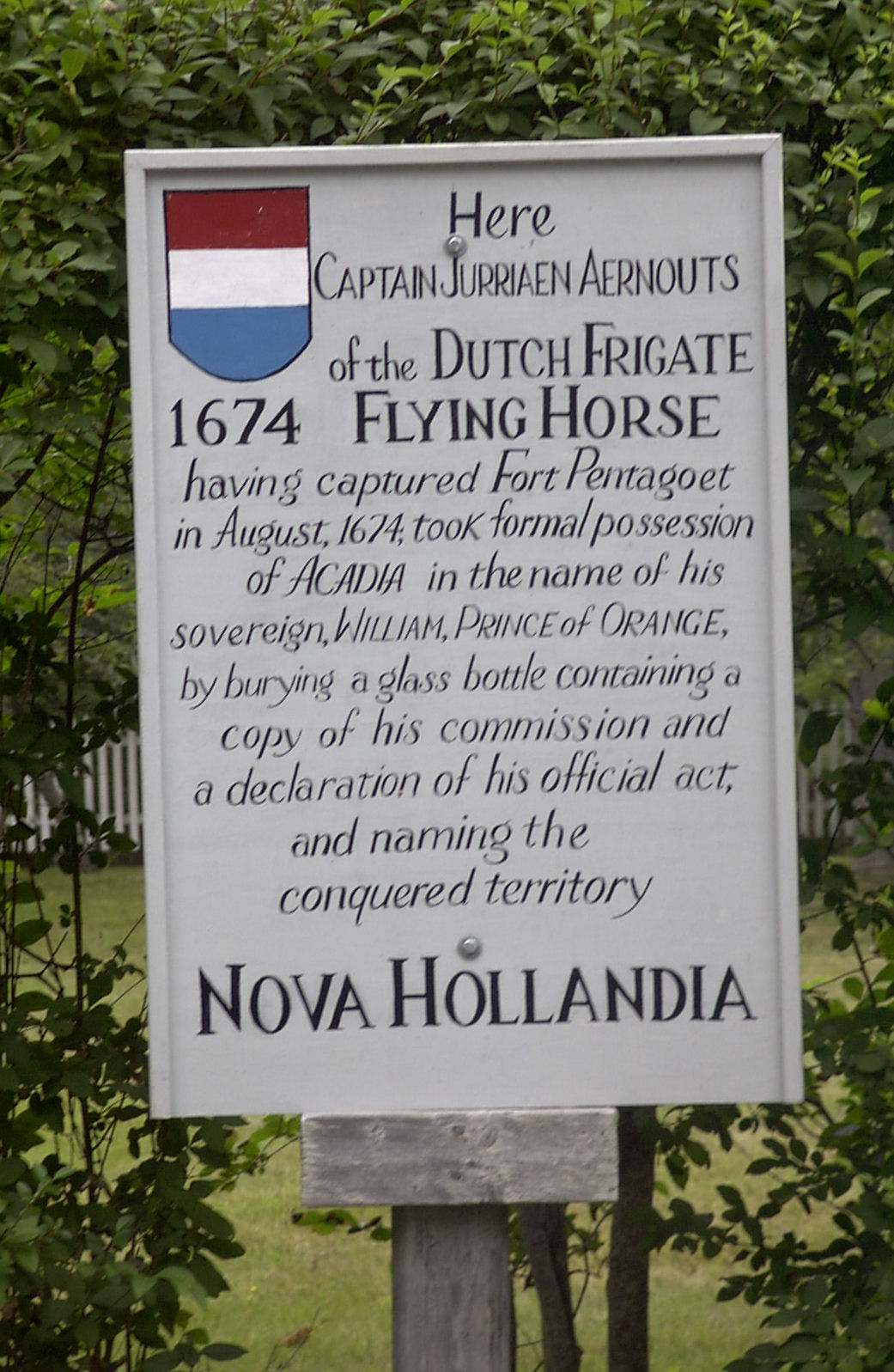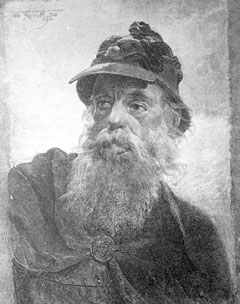Fort Pentagoet on:
[Wikipedia]
[Google]
[Amazon]
 Fort Pentagouët (Fort Pentagoet, Fort Castine, Fort Penobscot, Fort Saint-Pierre) was a French fort established in present-day Castine, Maine, which was the capital of Acadia (1670–1674). It is the oldest permanent settlement in New England.
Its commanding position at the mouth of the
Fort Pentagouët (Fort Pentagoet, Fort Castine, Fort Penobscot, Fort Saint-Pierre) was a French fort established in present-day Castine, Maine, which was the capital of Acadia (1670–1674). It is the oldest permanent settlement in New England.
Its commanding position at the mouth of the
 During the
During the
 From 1667, after the Treaty of Breda, until 1700, Saint-Castin, former ensign at Fort Pentagoet, re-established French authority nearby at a small trading post that formed a nucleus of a new French and Indian habitation. French authorities dispatched the Baron Jean-Vincent de Saint-Castin to take command of Pentagouët. The baron married an Abenaki woman, the daughter of the sachem Modockawando. She adopted the French name Mathilde and bore him 10 children.http://www.acadiansingray.com/Appendices-Acadian%20Marriages.htm White,''Dictionnaire Acadiennes'' The baron became a widower and then married another Abenaki woman named Marie Pidiwammiskwa who bore him two additional children. Castine soon became a force in colonial trade and diplomacy.
After 1677, Saint-Castin returned to his trading post within a village of 160 Etchemin Indians - two European buildings within a settlement of thirty-two wigwams.
From 1667, after the Treaty of Breda, until 1700, Saint-Castin, former ensign at Fort Pentagoet, re-established French authority nearby at a small trading post that formed a nucleus of a new French and Indian habitation. French authorities dispatched the Baron Jean-Vincent de Saint-Castin to take command of Pentagouët. The baron married an Abenaki woman, the daughter of the sachem Modockawando. She adopted the French name Mathilde and bore him 10 children.http://www.acadiansingray.com/Appendices-Acadian%20Marriages.htm White,''Dictionnaire Acadiennes'' The baron became a widower and then married another Abenaki woman named Marie Pidiwammiskwa who bore him two additional children. Castine soon became a force in colonial trade and diplomacy.
After 1677, Saint-Castin returned to his trading post within a village of 160 Etchemin Indians - two European buildings within a settlement of thirty-two wigwams.
 , held in slavery by Madockawando for attempting to escape, were tortured by fire, compelled to eat their noses and ears and then burned to death at the stake" (Se
, held in slavery by Madockawando for attempting to escape, were tortured by fire, compelled to eat their noses and ears and then burned to death at the stake" (Se
John Gyles' captivity narrative, p. 10-11
.. During King William's War, Castin's settlement was plundered by English Governor Sir Edmund Andros in 1688. In response, Saint-Castin led an Abenaki war party to raid the English settlement at Pemaquid (present-day Bristol, Maine) in August 1689. During the Siege of Pemaquid (1689), one of the captives the
Fort Pentagouet. Collections of the Maine Historical Society, Vol. 4, 1893. p. 113
Alaric Faulkner. Maintenance and Fabrication at Fort Pentagoet 1635-1654: Products of an Acadian Armorer’s Workshop
Images of Fort Pentagoet
* Roberts, Robert B., Encyclopedia of Historic Forts: The Military, Pioneer, and Trading Posts of the United States, Macmillan, New York, 1988, 10th printing, {{ISBN, 0-02-926880-X, page 369
George Augustus Wheeler
. Fort Pentagoet and the French occupation of Castine. Maine Historical Society, 1893, p. 113">George Augustus Wheeler"> George Augustus Wheeler
. Fort Pentagoet and the French occupation of Castine. Maine Historical Society, 1893, p. 113 Acadian history History of Maine Military history of Acadia Colonial forts in Maine, Pentagouet 1613 establishments in the French colonial empire French forts in the United States, Pentagouet King William's War
 Fort Pentagouët (Fort Pentagoet, Fort Castine, Fort Penobscot, Fort Saint-Pierre) was a French fort established in present-day Castine, Maine, which was the capital of Acadia (1670–1674). It is the oldest permanent settlement in New England.
Its commanding position at the mouth of the
Fort Pentagouët (Fort Pentagoet, Fort Castine, Fort Penobscot, Fort Saint-Pierre) was a French fort established in present-day Castine, Maine, which was the capital of Acadia (1670–1674). It is the oldest permanent settlement in New England.
Its commanding position at the mouth of the Penobscot River
The Penobscot River (Abenaki: ''Pαnawάhpskewtəkʷ'') is a U.S. Geological Survey. National Hydrography Dataset high-resolution flowline dataThe National Map, accessed June 22, 2011 river in the U.S. state of Maine. Including the river's We ...
estuary, a lucrative source of furs and timber, as well as a major transportation route into the interior, made the peninsula of particular interest to European powers in the 17th century. Majabagaduce (as the Abenaki name would be corrupted) changed hands numerous times with shifting imperial politics. At one time or another, it was occupied by the French
French (french: français(e), link=no) may refer to:
* Something of, from, or related to France
** French language, which originated in France, and its various dialects and accents
** French people, a nation and ethnic group identified with Franc ...
, Dutch and England's Plymouth Colony.
La Tour
Castine was founded in the winter of 1613, when Claude de Saint-Étienne de la Tour established a small trading post to conduct business with the Tarrantine Indians (now called the Penobscots). After the trading post was established at Castine, a raid by English captain Samuel Argall at Mount Desert Island in 1613 signaled the start of a long-running dispute over the boundary between French Acadia to the north and the English colonies to the south. There is evidence that La Tour immediately challenged the English action by re-establishing his trading post in the wake of Argall's raid. Captain John Smith charted the area in 1614 and referred to French traders in the vicinity. In 1625, Charles de Saint-Étienne de la Tour erected a fort named Fort Pentagouët. English colonists from the Plymouth Colony seized it in 1629, and made it an administrative outpost of their colony.Faulkner and Faulkner, p. 219Aulnay
From 1635 to 1654, Charles de Menou d'Aulnay de Charnisay defended his private commercial interests at Fort Pentagoet. In 1635, it was retaken by the French and again incorporated into Acadia; Governor Isaac de Razilly sent Charles de Menou d'Aulnay de Charnisay to retake the village. In 1638, Aulnay built a more substantial fort named Fort Saint-Pierre. While he had other ventures in Acadia, Fort Pentagoet was his major outpost on the frontier with New England. Emmanuel Le Borgne with 100 men raided the settlement in 1653. Major GeneralRobert Sedgwick
Major General Robert Sedgwick (c. 1611 – 1656) was an English colonist, born 1611 in Woburn, Bedfordshire, England, and baptised on 6 May 1613.
Biography
He was the son of William Sedgwick of London, and brother of English priest William ...
led 100 New England volunteers and 200 of Oliver Cromwell's soldiers on an expedition against Acadia in 1654. Before taking its capital Port Royal
Port Royal is a village located at the end of the Palisadoes, at the mouth of Kingston Harbour, in southeastern Jamaica. Founded in 1494 by the Spanish, it was once the largest city in the Caribbean, functioning as the centre of shipping and co ...
, Sedgwick captured and plundered the French settlement at Pentagouët. The English occupied Acadia for the next 16 years and Fort Pentagouët saw very little use.
Capital of Acadia
From 1670, when Acadia was returned to the French, Fort Pentagouët became the Capital of Acadia under two Governors Hector d'Andigné de Grandfontaine (1670–73) andJacques de Chambly
Jacques de Chambly (died 1687) was from a French military background and became a seigneur in the New World and a governor of Acadia.
Chambly arrived in New France in 1665 when he was a captain in the Carignan-Salières Regiment
The Carig ...
(1673-74), both formerly of the Carignan-Salières Regiment
The Carignan-Salières Regiment was a Piedmont French military unit formed by merging two other regiments in 1659. They were led by the new Governor, Daniel de Rémy de Courcelles, and Lieutenant-General Alexandre de Prouville, Sieur de Tracy. ...
. (Saint-Castin had already set up his near-by trading post three years earlier in 1667).
Franco-Dutch War
The Franco-Dutch War, also known as the Dutch War (french: Guerre de Hollande; nl, Hollandse Oorlog), was fought between France and the Dutch Republic, supported by its allies the Holy Roman Empire, Spain, Brandenburg-Prussia and Denmark-Nor ...
(1674), Pentagouët and other Acadian ports were captured by the Dutch captain Jurriaen Aernoutsz
Jurriaen Aernoutsz (or Aernouts) was a Dutch colonial navy captain, who briefly conquered the capital of Acadia, Fort Pentagouet in Penobscot Bay (present day Castine, Maine) and several other villages, and renamed the colony New Holland during t ...
who arrived from New Amsterdam
New Amsterdam ( nl, Nieuw Amsterdam, or ) was a 17th-century Dutch settlement established at the southern tip of Manhattan Island that served as the seat of the colonial government in New Netherland. The initial trading ''factory'' gave rise ...
, renaming Acadia, New Holland. The Dutch turned the fort's cannon on its own walls and destroyed most of it after the second siege. Saint-Castin himself retook it in 1676 and renamed the town Bagaduce, a shortened version of Majabagaduce.
The Habitation of Saint-Castine
 From 1667, after the Treaty of Breda, until 1700, Saint-Castin, former ensign at Fort Pentagoet, re-established French authority nearby at a small trading post that formed a nucleus of a new French and Indian habitation. French authorities dispatched the Baron Jean-Vincent de Saint-Castin to take command of Pentagouët. The baron married an Abenaki woman, the daughter of the sachem Modockawando. She adopted the French name Mathilde and bore him 10 children.http://www.acadiansingray.com/Appendices-Acadian%20Marriages.htm White,''Dictionnaire Acadiennes'' The baron became a widower and then married another Abenaki woman named Marie Pidiwammiskwa who bore him two additional children. Castine soon became a force in colonial trade and diplomacy.
After 1677, Saint-Castin returned to his trading post within a village of 160 Etchemin Indians - two European buildings within a settlement of thirty-two wigwams.
From 1667, after the Treaty of Breda, until 1700, Saint-Castin, former ensign at Fort Pentagoet, re-established French authority nearby at a small trading post that formed a nucleus of a new French and Indian habitation. French authorities dispatched the Baron Jean-Vincent de Saint-Castin to take command of Pentagouët. The baron married an Abenaki woman, the daughter of the sachem Modockawando. She adopted the French name Mathilde and bore him 10 children.http://www.acadiansingray.com/Appendices-Acadian%20Marriages.htm White,''Dictionnaire Acadiennes'' The baron became a widower and then married another Abenaki woman named Marie Pidiwammiskwa who bore him two additional children. Castine soon became a force in colonial trade and diplomacy.
After 1677, Saint-Castin returned to his trading post within a village of 160 Etchemin Indians - two European buildings within a settlement of thirty-two wigwams.
King William's War
 , held in slavery by Madockawando for attempting to escape, were tortured by fire, compelled to eat their noses and ears and then burned to death at the stake" (Se
, held in slavery by Madockawando for attempting to escape, were tortured by fire, compelled to eat their noses and ears and then burned to death at the stake" (SeJohn Gyles' captivity narrative, p. 10-11
.. During King William's War, Castin's settlement was plundered by English Governor Sir Edmund Andros in 1688. In response, Saint-Castin led an Abenaki war party to raid the English settlement at Pemaquid (present-day Bristol, Maine) in August 1689. During the Siege of Pemaquid (1689), one of the captives the
Maliseet
The Wəlastəkwewiyik, or Maliseet (, also spelled Malecite), are an Algonquian-speaking First Nation of the Wabanaki Confederacy. They are the indigenous people of the Wolastoq ( Saint John River) valley and its tributaries. Their territory ...
took back to their main village, Meductic, was John Gyles
John Gyles (1680 at Pemaquid, Maine1755 at Roxbury, Boston) was an interpreter and soldier, most known for his account of his experiences with the Maliseet tribes at their headquarters at Meductic, on the Saint John River.
King William's ...
, who created one of the few captivity narratives to come out of Nova Scotia/Acadia. John Gyles' brother James was also captured by the Penobscot and eventually taken back to Fort Penobscot where he was tortured and burned alive at the stake.
In 1692 the village was again seized by the English, when Major Benjamin Church destroyed the fort and looted the settlement. With the return of Baron de Saint-Castin and his sons to France, the settlement became sparsely occupied.
Queen Anne's War
During Queen Anne's War, in response to the French Raid on Deerfield in February 1704, New England Colonel Benjamin Church raided Castin's settlement (then known as Penobscot) before moving on to raid other Acadian villages at present-daySt. Stephen, New Brunswick
St. Stephen (2016 population: 4,415) is a Canadian town in Charlotte County, New Brunswick, situated on the east bank of the St. Croix River around the intersection of New Brunswick Route 170 and the southern terminus of New Brunswick Route ...
, Grand Pré
Grand may refer to:
People with the name
* Grand (surname)
* Grand L. Bush (born 1955), American actor
* Grand Mixer DXT, American turntablist
* Grand Puba (born 1966), American rapper
Places
* Grand, Oklahoma
* Grand, Vosges, village and com ...
, Pisiguit (present-day Windsor, Nova Scotia), and Chignecto. St. Castin's daughter was taken in the raid.Benjamin Church, Thomas Church, Samuel Gardner Drake. The history of King Philip's war ; also of expeditions against the French and Indians in its Eastern parts of New England, in the years 1689, 1692, 1696 AND 1704. With some account of the divine providence towards Col. Benjamin Church.p. 261
See also
* Pentagoet Archeological DistrictReferences
;Endnotes ;Texts * Faulkner, Alaric, and Gretchen F. Faulkner. 1994. Fort Pentagoet and Castin's Habitation: French Ventures in Acadian Maine, Chapter 10 in Norumbega: Maine in the Age of Exploration and Settlement, Emerson W. Baker, Edwin A. Churchill, Kristine L. Jones, et al. editors, University of Nebraska Press, Lincoln, pp. 217–240.Fort Pentagouet. Collections of the Maine Historical Society, Vol. 4, 1893. p. 113
External links
Alaric Faulkner. Maintenance and Fabrication at Fort Pentagoet 1635-1654: Products of an Acadian Armorer’s Workshop
Images of Fort Pentagoet
* Roberts, Robert B., Encyclopedia of Historic Forts: The Military, Pioneer, and Trading Posts of the United States, Macmillan, New York, 1988, 10th printing, {{ISBN, 0-02-926880-X, page 369
. Fort Pentagoet and the French occupation of Castine. Maine Historical Society, 1893, p. 113">George Augustus Wheeler"> George Augustus Wheeler
. Fort Pentagoet and the French occupation of Castine. Maine Historical Society, 1893, p. 113 Acadian history History of Maine Military history of Acadia Colonial forts in Maine, Pentagouet 1613 establishments in the French colonial empire French forts in the United States, Pentagouet King William's War